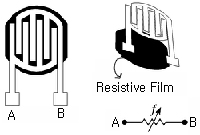
[ 1. Resistance (Ohms) vs. Force (g) for an Interlink FSR ]
FSRs are also known as "Pressure Sensing", "Force Sensitive Resistors", etc. Force Sensing Resistors (FSRs) are a type of resistor whose resistance changes when a force or pressure is applied. The resistance is inversely proprotional to the force applied, i.e. the resistance decreases as the force gets increases. Here is a graph showing that relationship:

FSRs come in a few shapes and sizes. The basic FSR is a little round button. But there are also FSRs that are long strips which can sense both position and pressure, and even FSR matrices which can sense x,y position and pressure. But apparently you need this complicated circuit to make these work accurately.


A force sensing resistor is a piezoresistivity conductive polymer, which changes resistance in a predictable manner following application of force to its surface. It is normally supplied as a polymer sheet which has had the sensing film applied by screen printing. The sensing film consists of both electrically conducting and non-conducting particles suspended in matrix. The particle sizes are of the order of fraction of microns, and are formulated to reduce the temperature dependence, improve mechanical properties and increase surface durability. Applying a force to the surface of a the sensing film causes particles to touch the conducting electrodes, changing the resistance of the film. As with all resistive based sensors the force sensitive resistor requires a relatively simple interface and can operate satisfactorily in moderately hostile environments. (this paragraph stolen from this page about tactile sensing.)
Unfortunately, FSRs are not easy to find. I was only able to find two suppliers, one of which is in the UK:
Interlink Electronics